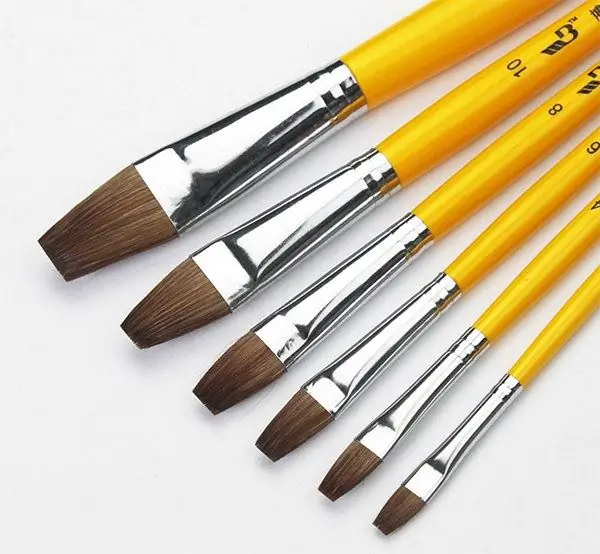- Author Antonio Harrison [email protected].
- Public 2023-12-16 07:44.
- Last modified 2025-01-22 21:44.
Only soft brushes are suitable for painting with watercolors. They are usually made from natural materials, but soft synthetic brushes are gaining popularity lately.

Squirrel brushes
The most popular watercolor brushes are the squirrel brushes. They collect water perfectly and then give it away for a long time, which is very important for drawing with watercolors. The correct squirrel brush should be from squirrel tail hair, but if it is from skin hair, its performance will be much worse. When buying a brush, you must definitely test it: dip it in water - the bristles of a good product when wet will converge into a thin tip.
Due to the fact that the brush converges at the tip, it can be used to paint with any strokes, both large and small details.
Column brushes
Column brushes are also very popular. The bristles of the column have a special scaly structure that allows them to pick up more paint and give it evenly onto the canvas. At the same time, the brushes from the column collect less water than squirrel brushes, so it is more convenient to paint with them small details that can be spoiled by excess water. Like squirrel brushes, the kolinsky brushes should converge to the tip when wet.
Novice artists can be advised not to buy expensive kolinkovy brushes, but to replace them with cheaper mixed ones, in such brushes the column bristles are mixed with synthetic bristles.
Synthetic brushes
Modern synthetic materials make it possible to make artificial soft brushes that are close in their properties to natural ones. The price of synthetic brushes is much lower, but even the best of them do not provide the same quality of brush strokes and paint recoil as natural ones. Such brushes can be safely chosen by amateur artists.
Shape and size of brushes
All brushes are numbered, the higher the number, the larger the stroke such a brush can make. Accordingly, in order to draw small details and outlines, use a smaller number of brushes, and for fills and backgrounds - a larger number.
For the most part, round brushes are used for painting, but if you want to diversify your technique, you can use brushes of other shapes - flat ones, which give an interesting oblique stroke; Japanese - Universal brushes for non-tear-off painting.
Synthetic Flute is a special very wide brush for creating watercolor fills.
In the arsenal of a professional artist there should be brushes of various shapes, sizes and types, but the following set of brushes is suitable for novice watercolorists - two squirrel brushes - number three and number six and two column brushes - number one and number four.






